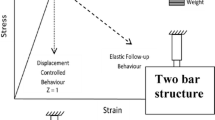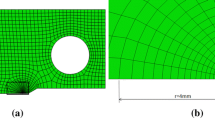Abstract
We have followed the evolution of strain near the tip of an arresting cleavage crack in a pressure vessel steel using a strain gage technique. The measurements were made using a linear array of strain gages located along the intended crack path and 0.65B (B is the specimen thickness) above this plane. The gages were read using instrumentation capable of resolving strain in time intervals of between 2 and 4µs. The results were obtained in a thick plate, large enough that reflected elastic waves did not contribute significantly to the strain records or crack motion during the time interval of interest.
To within the resolution of this technique, the gages did not detect plasticity near the rapidly propagating cleavage crack tip. At the instant of arrest, however, the strain gages detected a plastic zone which increased in intensity over a period of several milliseconds. We have interpreted this increasing intensity as an elastic-plastic boundary emanating from the arresting crack tip and eventually reaching an equilibrium size, i.e., that predicted from the applied stress intensity factor and the static plastic properties. A simple analysis is presented to estimate the velocity of this elastic-plastic boundary from the strain data and results are given for several experiments.
Access this chapter
Tax calculation will be finalised at checkout
Purchases are for personal use only
Preview
Unable to display preview. Download preview PDF.
Similar content being viewed by others
References
D.K. Felbeck and E. Orowan, The Welding Journal Research Supplement 34 (1955) 5705–5765.
G.R. Irwin in Fracturing of Metals, American Society for Metals, Cleveland (1948) 147–166.
I.-H. Lin and R.M. Thomson, Journal of Materials Research 1 (1986) 73–80.
I.-H. Lin and R.M. Thomson, Acta Metallurgica 34 (1986) 187–206.
J.M. Etheridge and J.W. Dally, Experimental Mechanics 17 (1977) 248–254.
J.W. Dally and R.J. Sanford, Proceedings of 1985 Society for Experimental Mechanics Spring Conference on Experimental Mechanics (1985) 851–860.
R. deWit and R.J. Fields, Nuclear Engineering and Design 98 (1987) 149–155.
C.E. Pugh, D.J. Naus, B.R. Bass, R.K. Nanstad, R. deWit, R.J. Fields, S.R. Low III, International Journal of Pressure Vessels and Piping 31 (1988) 165–185.
G.A. Danko, S.R. Low III, R. deWit, and R.J. Fields, in Use of New Technology to Improve Mechanical Readiness, Reliability, and Maintainability, T.R. Shives (ed.), Cambridge University Press, Cambridge (1987).
G.R. Irwin, Applied Material Research 3 (1964) 65–81.
K. Hellan, Introduction to Fracture Mechanics, McGraw-Hill, New York (1984).
H. Tada, P.C. Paris, and G.R. Irwin, The Stress Analysis of Cracks Handbook 2nd Edition, Paris Productions, St. Louis (1985).
Author information
Authors and Affiliations
Editor information
Editors and Affiliations
Rights and permissions
Copyright information
© 1990 Springer Science+Business Media Dordrecht
About this chapter
Cite this chapter
Fields, R.J., deWit, R. (1990). Plastic zone formation around an arresting crack. In: Knauss, W.G., Rosakis, A.J. (eds) Non-Linear Fracture. Springer, Dordrecht. https://doi.org/10.1007/978-94-017-2444-9_15
Download citation
DOI: https://doi.org/10.1007/978-94-017-2444-9_15
Publisher Name: Springer, Dordrecht
Print ISBN: 978-90-481-4064-0
Online ISBN: 978-94-017-2444-9
eBook Packages: Springer Book Archive




